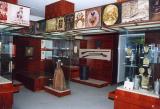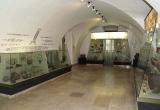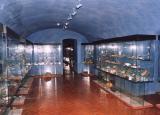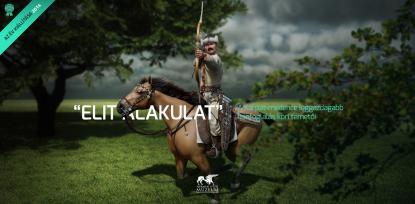
The first room presents the history of Miskolc from the time of the original settlement to the era of Ottoman rule. Unfortunately, we only had place enough to remember the most important moments in the history of Miskolc. The name of the town was first mentioned by the anonymous author of Gesta Hungarorum. In addition to presenting relics from the Original Settlement, the exhibition also offers documents and copies of a number of period contemporary charters. Diósgyőr, now district of Miskolc, prospered in the 14th century. The history of Diósgyőr is dealt with in the central section. The regal objects on display in this section suggest that the vicinity of the royal castle played an important part in the history of Miskolc. A replica of Giobanni Dalmata's wood carving known as the "Madonna of Diósgyőr" and the Gothic gate piece reflect on the architecture of the castle. The chalice with Gothic cloisonné enamel most probably served King Matthias and his court in the castle chapel. A wrought iron raven, the animal in the coat of arms of the order, reflects on The Order of Saint Paul the First Hermit of the various orders that inhabited the Bükk Hills.
The second unit in the first room implies that by the end of the 16th century, the religious, ethical and educational wave of Protestantism reached Hungary and took the people in Miskolc over. The influence of Calvinism has been influential on spiritual and educational life in town ever since. Replicas of bread bowls in the Avas Church collection are displayed in showcases in addition to beautiful pieces of Calvinist ecclesiastical art. This section presents communion table covers, tin cups and bowls. Next to these, one of the most treasured pieces in the museum collection, an eastern rug made in the 17th century is to be seen. The rug once ornamented the Avas Church.
The second room hosts objects and documents demonstrating the characteristics of economic life in the 17th century when guilds played the most crucial role. Trade also developed immensely in those days. Miskolc was famous for her wine, and the high income from wine marketing provided unusually high standards of living for citizens of Miskolc. The cloths of the Szepessy family from the 18th century on display are to represent this era. Manufacturing industry in the vicinity of the town started developing at the end of the 18th century. A number of glass foundries were built in the Bükk Hills, iron furnaces and hammersmith factories opened one after another. The first earthenware factory opened in Miskolc sometime in the first decade of the 19th century.
Records of the history of the industrial works is on display in room three, where the visitors can see the first sylviculture plan to utilize forests in the Bükk Hills. During the Hungarian Reform Era, then again during the War of Independence of 1848-49, Miskolc was Hungary's "capitol". Events that took place in the town greatly influenced politics in the region while many of the politicians born in Miskolc determined the politics of the country. The third room present the life and work of László Pálóczy and Bertalan Szemere who was first home secretary of Hungary, then prime minister. The two politicians played crucial role in the War of Independence and the reform era.





